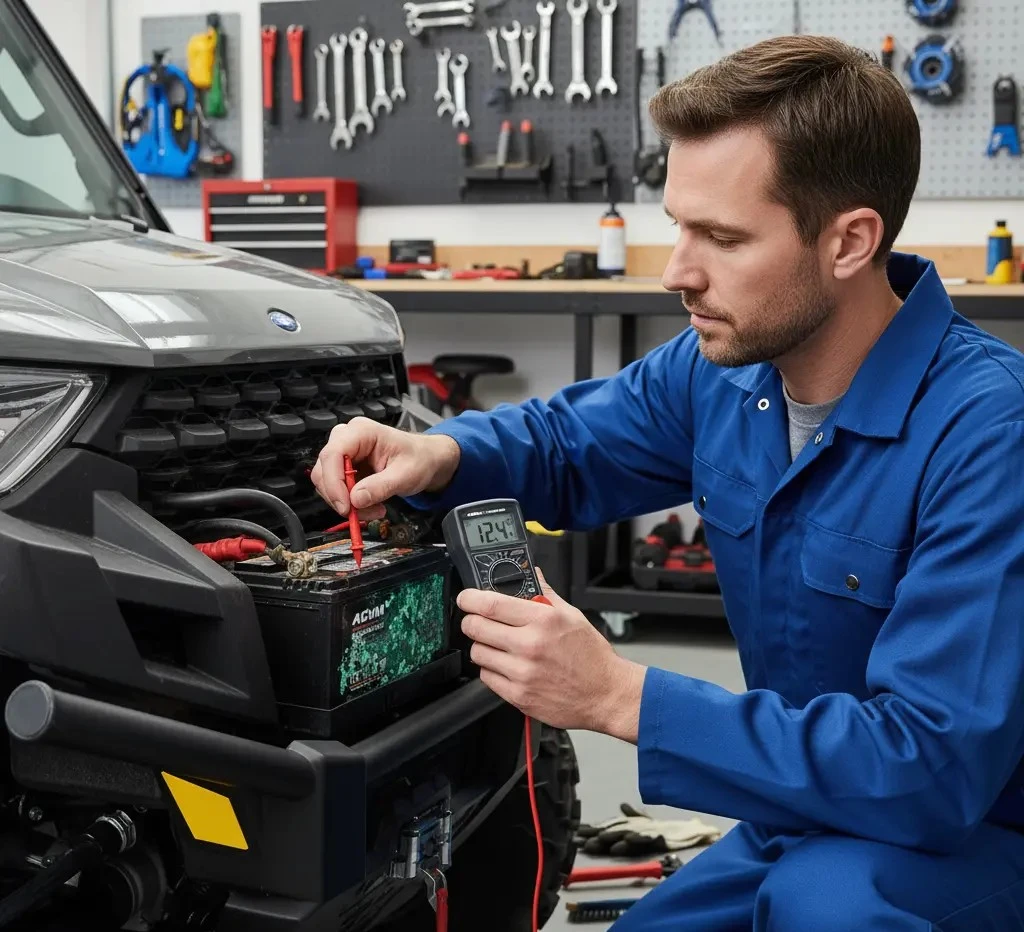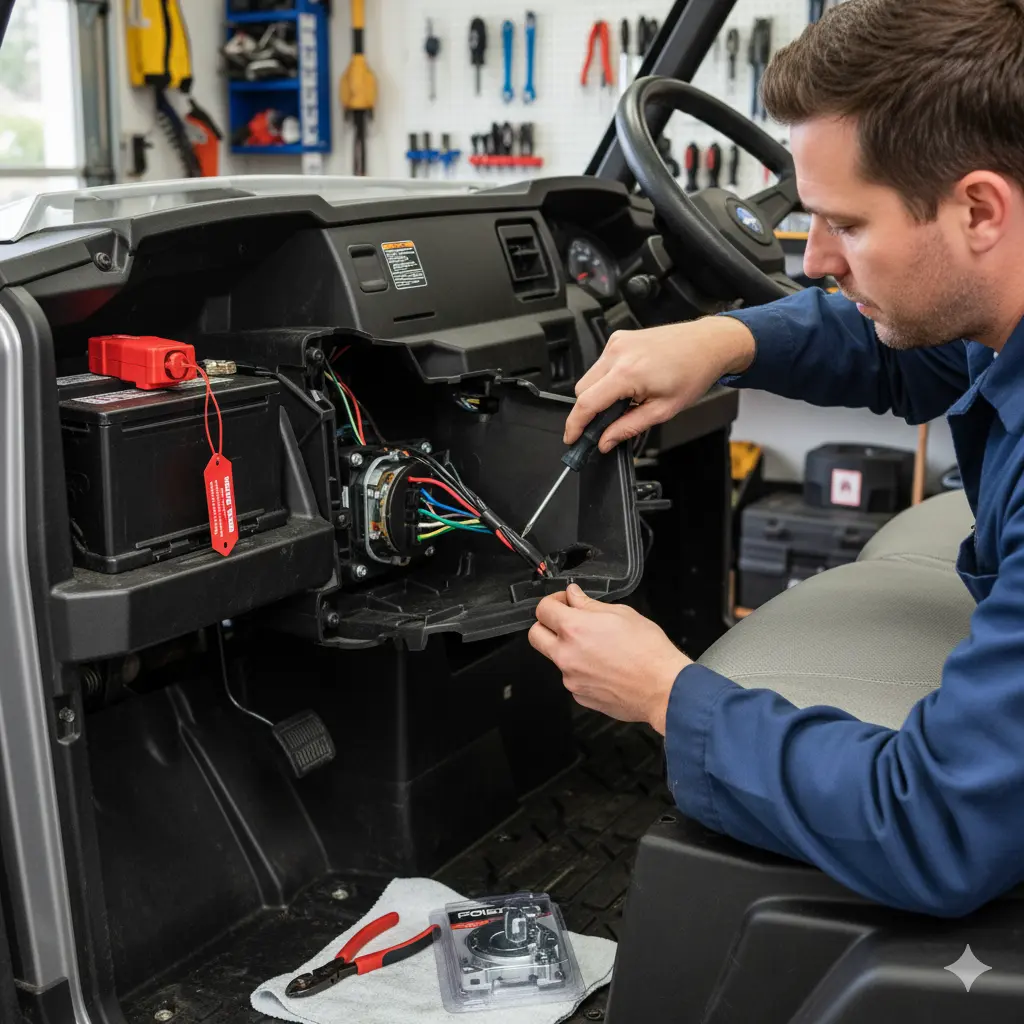Polaris Ranger starter problems can be frustrating for any owner. These issues often stop your vehicle from starting.
Understanding the common causes of these problems is crucial. You rely on your Polaris Ranger for work and play, so knowing what might go wrong can save you time and stress. Whether it’s a dead battery, faulty starter motor, or electrical issue, identifying the problem is the first step to fixing it.
“Starter issues are often linked with other mechanical failures, such as the Polaris Ranger Drive Shaft Problems.“
In this blog post, we’ll explore the typical starter problems that Polaris Ranger owners face. We’ll also provide some tips to troubleshoot and resolve these issues, ensuring your vehicle runs smoothly again. Stay tuned as we dive into the details and help you get back on the trail.
Common Starter Problems
When you’re out and about with your Polaris Ranger, the last thing you want is starter trouble. It can put a damper on your day faster than a flat tire. Understanding common starter problems can help you diagnose and fix issues quickly. Let’s dive into some typical problems you might encounter and how to address them.
“Sometimes starter problems occur along with Polaris Ranger 900 XP Problems, which cover a wider range of engine and electrical faults.”
Battery Issues
One of the most common reasons your Polaris Ranger won’t start is due to battery issues. Batteries, as we all know, have a limited lifespan. If your Ranger’s battery is old or weak, it may not have enough power to turn over the engine.

- Corroded Terminals: Check the battery terminals for corrosion. Corroded terminals can prevent the battery from delivering power efficiently.
- Loose Connections: Ensure all connections are tight. Loose connections can cause intermittent starting problems.
- Battery Voltage: Use a multimeter to check the battery voltage. A fully charged battery should read around 12.6 volts.
If you find any issues, clean the terminals, tighten connections, or consider replacing the battery if it’s over three years old.
Faulty Solenoid
Another culprit for starter problems can be a faulty solenoid. The solenoid is like the middleman between your battery and the starter. When you turn the key, the solenoid sends power to the starter motor.
- Clicking Sound: If you hear a clicking sound when you try to start the engine, it could indicate a bad solenoid.
- No Sound: No sound at all? The solenoid might be completely dead.
To diagnose a solenoid issue, you can use a voltmeter to check if power is reaching the starter. If not, it might be time to replace the solenoid. Fortunately, solenoids are relatively inexpensive and easy to replace.
In conclusion, while starter problems can be frustrating, they are often straightforward to diagnose and fix. Keep your battery in good condition and be mindful of the solenoid’s health, and you’ll be back on the trails in no time.
Diagnosing Electrical Issues
Polaris Ranger starter problems can often be traced back to electrical issues. Pinpointing the exact cause helps avoid unnecessary repairs. Start by looking at the battery and wiring.
Testing The Battery
The battery is the heart of the vehicle’s electrical system. A weak or dead battery can prevent the starter from functioning. Begin by checking the battery voltage with a multimeter. A fully charged battery should read around 12.6 volts. If the voltage is lower, charge the battery and test again. If it fails to hold a charge, replace it.
Next, inspect the battery terminals. Corrosion or loose connections can impede electrical flow. Clean any corrosion with a wire brush. Ensure the terminals are tight. This small step can often resolve starting issues.
Checking The Wiring
Wiring problems can also cause starter issues. Inspect the wires connected to the battery and starter. Look for signs of wear, fraying, or damage. Replace any damaged wires to ensure proper electrical flow.
Additionally, check the ground connections. Poor grounding can disrupt the electrical system. Ensure all ground wires are securely fastened and free of corrosion. A good ground connection is crucial for the starter to work properly.
Lastly, examine the starter relay and solenoid. These components direct power to the starter motor. If they malfunction, the starter won’t engage. Test these parts with a multimeter to confirm they are working.
Starter Motor Failure
Owning a Polaris Ranger can be a thrill, but what happens when it won’t start? Starter motor failure is a common issue that can leave you stuck. Understanding the symptoms and solutions can save you time and frustration. Let’s dive into the details of what happens when your starter motor decides to take a break.
Signs Of A Bad Starter Motor
The first step in solving starter motor issues is recognizing the signs. A bad starter motor can show itself in several ways:
- Clicking Sound: When you turn the key, do you hear a clicking noise but the engine doesn’t crank? This could be your starter motor acting up.
- Grinding Noise: Sometimes, a failing starter motor can produce a grinding sound as if the gears are not engaging correctly.
- No Response: You turn the key, and nothing happens. The silence can be deafening, and it’s a clear sign that the starter motor might be dead.
Recognizing these signs early can prevent further damage and save you from being stranded in the middle of nowhere.
Replacing The Starter Motor
Replacing the starter motor might sound like a daunting task, but it’s quite manageable with the right tools and some patience. Here’s a simple step-by-step guide:
- Gather Your Tools: You’ll need a wrench set, a new starter motor, and possibly a service manual for your specific Polaris Ranger model.
- Disconnect the Battery: Safety first! Always disconnect the battery before starting any work to avoid any electrical mishaps.
- Locate the Starter Motor: The starter motor is usually located near the bottom of the engine. Refer to your service manual if you’re having trouble finding it.
- Remove the Old Starter Motor: Unbolt the starter motor from the engine. Be careful with the wiring; disconnect it gently.
- Install the New Starter Motor: Position the new starter motor in place, secure it with bolts, and reattach the wiring.
- Reconnect the Battery: Once everything is in place, reconnect the battery and give it a try.
And just like that, you’re ready to hit the trails again! Remember, if you’re not comfortable doing this yourself, don’t hesitate to seek professional help.
Fixing starter motor issues doesn’t have to be a hassle. With a bit of knowledge and preparation, you can keep your Polaris Ranger running smoothly and avoid those unexpected breakdowns.
“If you also notice unusual grinding noises, you may want to check for Polaris Ranger Rear Differential Problems.”
Ignition Switch Problems
Ignition switch problems can cause significant issues with your Polaris Ranger. This crucial component controls the electrical power to your engine. A faulty ignition switch can lead to a non-starting vehicle. Understanding the symptoms can help you diagnose and fix the issue quickly.
Symptoms Of A Faulty Ignition Switch
A bad ignition switch may cause several noticeable symptoms. The engine may not turn over when you turn the key. You may also hear a clicking sound instead of the engine starting. Lights and other electrical components might not function correctly. These signs indicate a problem with the ignition switch.
Repairing Or Replacing The Ignition Switch
Fixing the ignition switch requires some mechanical skills. First, disconnect the battery to avoid any electrical hazards. Then, remove the steering column cover to access the ignition switch. Check the wiring for any visible damage. If the switch itself is faulty, replacing it is usually the best option. You can find replacement parts at most auto stores.

After replacing the switch, reconnect the battery and test the ignition. If the problem persists, consult a professional mechanic. Proper diagnosis and repair will ensure your Polaris Ranger runs smoothly again.
Solenoid Issues
Polaris Ranger starter problems can often be traced back to the solenoid. The solenoid is a small but crucial part of your vehicle’s starting system. It acts as a bridge between the battery and the starter motor. If the solenoid fails, your Ranger won’t start. This can be frustrating and inconvenient. Understanding solenoid issues can help you diagnose and fix the problem quickly.
Identifying Solenoid Problems
First, check for clicking sounds when you turn the key. A faulty solenoid often makes a clicking noise. If you hear this sound, the solenoid might be the issue. Next, look for signs of corrosion on the solenoid terminals. Corrosion can hinder electrical flow. Also, check if the starter motor engages when you bypass the solenoid. If it does, the solenoid is likely the problem.
Steps To Replace The Solenoid
Replacing the solenoid is a straightforward process. First, disconnect the battery to ensure safety. Next, locate the solenoid near the starter motor. Use a wrench to remove the mounting bolts. Then, disconnect the wires attached to the solenoid. Take note of their positions for reassembly. Install the new solenoid by reversing these steps. Reconnect the wires and secure the mounting bolts. Finally, reconnect the battery and test your Ranger. The engine should start smoothly if the solenoid was the issue.

Battery Maintenance
So, you’ve encountered issues with your Polaris Ranger starter? It’s a common problem, but the solution often lies in a simple area: battery maintenance. Keeping your battery in top shape is crucial for a smooth start. Let’s dive into some essential tips on battery maintenance that can save you a lot of headaches.
Proper Charging Techniques
First things first, charging your battery the right way is vital. If you charge it improperly, you might shorten its lifespan or, worse, damage it. Here’s what you need to know:
- Use the Right Charger: Always use a charger that matches the specifications of your Polaris Ranger battery. Using the wrong one can lead to overcharging.
- Avoid Overcharging: Overcharging can overheat and damage the battery. Make sure to monitor the charging process and disconnect the charger once it’s full.
- Charge in a Well-Ventilated Area: Charging batteries can produce gases. Make sure you do it in a place where there is good air circulation.
Remember, proper charging is like giving your battery a breath of fresh air. Treat it well, and it will last longer!
Regular Battery Inspection
Inspecting your battery regularly can help you catch problems early. Here’s how you can do it:
- Check for Corrosion: Look at the battery terminals. If you see a white, ashy substance, it’s corrosion. Clean it with a mixture of baking soda and water.
- Examine the Cables: Ensure that the cables are tight and free of damage. Loose or frayed cables can prevent the battery from charging properly.
- Test the Voltage: Use a multimeter to check the battery’s voltage. A healthy battery should read around 12.6 volts when fully charged.
Here’s a little story: My friend once ignored a small bit of corrosion on his battery terminals. A few weeks later, his Polaris Ranger wouldn’t start at all. A quick clean-up and, voila, problem solved! So, don’t underestimate the power of regular checks.
By following these tips on proper charging techniques and regular battery inspection, you can ensure that your Polaris Ranger’s battery remains in good condition. This simple maintenance can help avoid starter problems and keep your vehicle running smoothly.
Preventive Measures
To ensure the longevity of your Polaris Ranger’s starter, preventive measures are crucial. Regular care can save you from costly repairs and downtime. Implementing a few simple practices will help keep your vehicle in top shape.
Routine Maintenance Tips
Regular maintenance is key to avoiding starter problems. Start by checking the battery and cables for any signs of wear. Clean the terminals to ensure a good connection. Inspect the starter motor for any unusual noises or issues.
Lubricate moving parts as needed. This can prevent them from seizing up. Replace worn-out parts promptly to avoid further damage. Regularly examine the wiring and connections for any signs of corrosion or damage.
Using Quality Parts
Using high-quality parts can make a significant difference. Cheap or substandard parts may save money initially. But they can lead to bigger problems down the road.
Invest in OEM parts designed for your Polaris Ranger. These parts are built to meet strict standards. They ensure compatibility and longevity. Quality parts can handle the demands of your vehicle better.
Always consult your owner’s manual before making any replacements. Following the manufacturer’s recommendations helps maintain your vehicle’s performance. It also ensures the safety of your Polaris Ranger.
When To Seek Professional Help
Sometimes, despite your best efforts, your Polaris Ranger just won’t start. It can be frustrating, especially when you’ve tried everything you know. But don’t worry; there comes a time when seeking professional help is the best option. Knowing when to throw in the towel and call an expert can save you time, money, and a whole lot of stress. So, let’s dive in and explore when you should consider reaching out to a professional mechanic.
“In severe cases, you may find yourself facing not just starter issues but also Polaris Ranger Drive Shaft Problems or even Polaris Ranger 900 XP Problems.”
Identifying Complex Issues
At times, the problem may be beyond your DIY skills. Maybe you’ve checked the battery, the cables, and the starter itself, but nothing seems to work. Here are a few signs that the issue might be more complex:
- Unusual noises when trying to start the engine.
- Smell of burning or smoke coming from the starter area.
- Starter motor turning but not engaging with the engine.
If you encounter any of these symptoms, it’s a clear sign that you need professional help. Complex electrical issues, internal engine problems, or intricate mechanical failures are best left to the experts. They have the tools and experience to diagnose and fix these advanced issues.
Finding A Reliable Mechanic
Once you’ve decided to seek professional help, the next step is finding a reliable mechanic. Here’s how you can go about it:
- Ask for Recommendations: Talk to friends or family who own Polaris Rangers. Personal experiences are invaluable.
- Check Online Reviews: Websites like Yelp and Google Reviews can provide insights into a mechanic’s reputation.
- Visit Local Shops: Sometimes, a face-to-face conversation can tell you a lot about the service you can expect.
- Check Certifications: Make sure the mechanic is certified and has experience with Polaris vehicles.
A good mechanic will not only fix your problem but will also provide tips to prevent future issues. Remember, a stitch in time saves nine!
So, the next time your Polaris Ranger gives you a hard time, don’t hesitate to seek professional help. It can make all the difference.
Frequently Asked Questions
Why Is My Polaris Ranger Not Starting?
Your Polaris Ranger might not start due to a dead battery, faulty spark plug, or fuel system issues. Check these components first.
How Do You Test A Polaris Starter Solenoid?
To test a Polaris starter solenoid, use a multimeter. Check for voltage at the solenoid terminals. Ensure the solenoid clicks when activated.
What Is High Miles For A Polaris Ranger?
High miles for a Polaris Ranger typically exceed 7,000 miles. Regular maintenance can extend its lifespan.
Where To Spray Starter Fluid On Polaris Ranger?
Spray starter fluid into the air intake of your Polaris Ranger. Locate it near the engine’s throttle body.
What Are Common Polaris Ranger Starter Problems?
Common issues include a dead battery, faulty starter motor, and loose or corroded connections.
Why Won’t My Polaris Ranger Start?
Check the battery, starter motor, and connections. These are common culprits for starting problems.
Conclusion
Fixing Polaris Ranger starter problems can be straightforward with the right steps. Regular maintenance helps keep the starter in good condition. Always check connections and the battery first. Seek professional help if the issue persists. A smooth start ensures a better ride every time.
Keep your Ranger reliable and ready for any adventure.
“For a complete understanding of Polaris performance, explore our troubleshooting guides on the Polaris Ranger Rear Differential Problems and the Polaris Ranger Drive Shaft Problems.”

